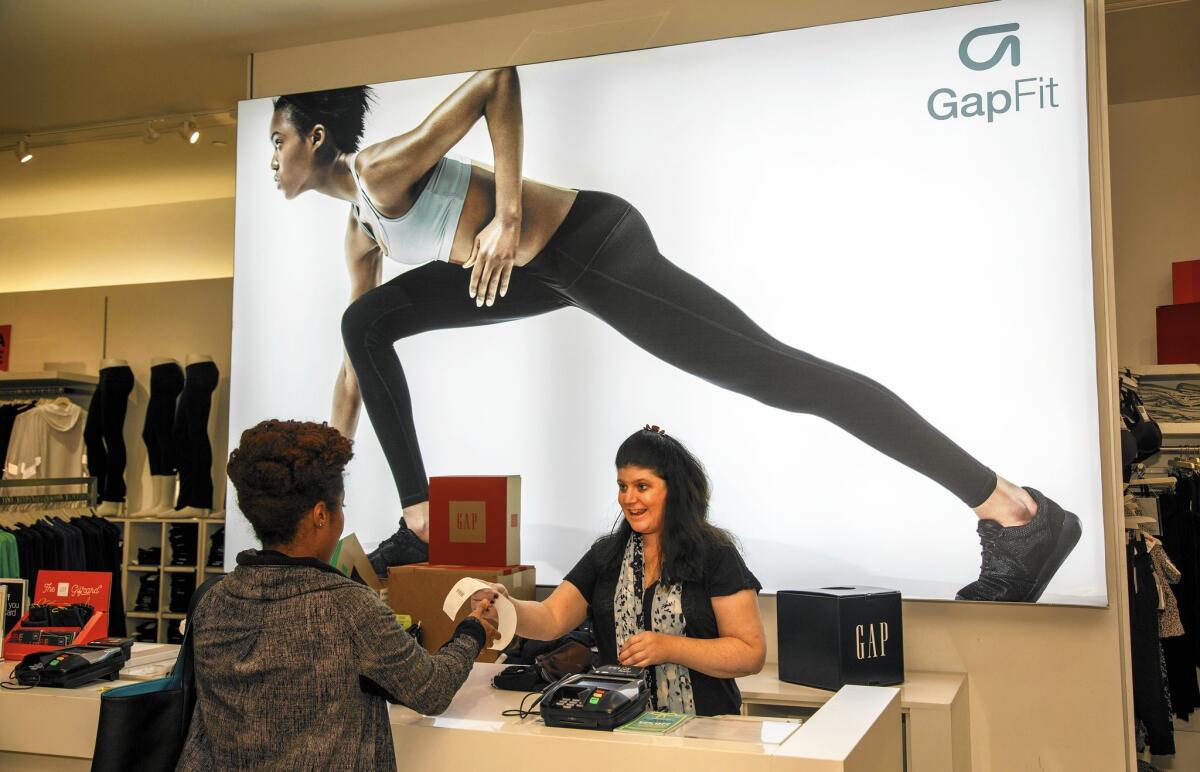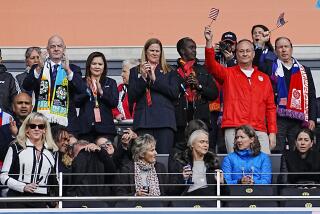Gap says audits show its workers get equal pay for the same work

Since the California Fair Pay Act was signed into law last month, companies have been scrambling to check their books, review their hiring statistics and get legal guidance to navigate what’s being called the toughest equal wage statute in the country.
The new law is turning the spotlight on hundreds of companies where men and women are paid unequal wages despite having similar duties.
But one well-known San Francisco apparel firm is getting attention for its effort to help close the gender wage gap. Gap Inc. says its male and female employees are paid an equal wage for equal work.
------------
FOR THE RECORD: A previous version of this article referred to Dan Henkle as Gap’s senior vice president of human resources. That was his previous job. Henkle’s current title is president of the Gap Foundation and senior vice president of global sustainability.
------------
“I think Gap is unique in having its leadership heavily led by women,” said Noreen Farrell, executive director of civil rights organization Equal Rights Advocates, which co-sponsored the California Fair Pay Act. “I think that’s very important in terms of the priority of the organization and its credibility come audit time.”
The new law seeks to close loopholes in existing legislation and ensure that men and women workers doing “substantially similar” work — regardless of title differences or being at a different work site under the same employer — get paid an equal wage.
Employers are prohibited from retaliating against employees who ask about their pay or that of their co-workers, and must justify wage differences based on factors such as seniority, merit, education or training. The law goes into effect Jan. 1.
The legislation is consistent with Gap’s own practices, the company says. Last year, the retailer performed internal and external audits to determine whether its more than 130,000 men and women employees were being paid equally for equal work. Both analyses found that they were, and the results were validated again this year.
The company has a long history of having women in senior leadership positions, starting with its co-founder, Doris Fisher. Fisher and her husband, Donald, started Gap in 1969. The couple formed the firm as a partnership, with each spouse putting in an equal amount of money, said Dan Henkle, Gap senior vice president of global sustainability and president of the Gap Foundation.
“If you have senior women at the table from the very beginning, you think about hiring decisions, promotion decisions, compensation decisions,” he said. “It became a way of doing business.”
It was the company’s 45th anniversary preparations last year that sparked the idea of a wage audit. While reflecting on its history, Gap executives said they decided to look at their employees’ wages and whether they were the same for men and women doing equal jobs. The results were so positive that they started to second-guess their work.
They brought in an outside expert — Exponential Talent, a consulting firm based in the San Francisco Bay Area city of Alameda that focuses on gender and diversity issues.
“I’ve never had a client say ... ‘Here’s all the work we had done, poke holes in it, rip it apart and tell us if we’ve made a mistake,” said Beth Roberts, diversity and inclusion analytics leader at Exponential Talent, who worked on the Gap audit. “We found their work to be accurate, and the results were correct, but we thought there were other tests we could do.”
Over the next few months, the consulting firm ran a number of statistical tests. They looked at full-time and part-time worker salaries by gender, adjusted for experience and also checked to make sure that one region’s salaries weren’t masking pay gaps in other areas.
“You would expect to find something,” Roberts said. “There just wasn’t a statistically significant difference.”
Part of the company’s success lies in its employee classification, Farrell said. Firms with an established system of job titles and pay grades that clearly define the work being done are easier to audit for potential wage gaps, she said.
The retailer also eliminated traditional performance reviews last year, replacing them with an “evidence-based performance management system” that emphasizes performance metrics rather than more “subjective” evaluations, Henkle said.
Companies that have more women in leadership positions also tend to prioritize equality issues, Farrell said. Gap’s employee base is 74% female, and 73% of store managers are women. At the senior leadership level, 77% are women.
“Obviously we think that paying women and men equally for equal work is the right thing to do,” Henkle said. “But we also think it’s a smart business decision.”
There are limits to the audit — the compensation data only cover company employees, not supply chain workers.
“As you get into the supply chain, it’s much more complicated because we work with a number of different suppliers,” Henkle said.
Gap has been criticized for its treatment of supply chain workers, Farrell said. A March report from Human Rights Watch said workers at a small subcontractor factory in Cambodia that periodically produced clothes for Gap until at least December 2013 were repeatedly given short-term contracts without the benefits given to long-term workers. The report also said the factory allegedly discriminated against pregnant workers at the time of hiring.
“Equality in any segment in a company’s workforce is laudable,” Farrell said. “But overall, a company’s reputation often hinges on a broader analysis, and I think being as committed to the economic security of its supply chain employees as the Gap is to equal pay for equal work will only improve the Gap’s standing as a leader in the industry.”
Gap spokeswoman Laura Wilkinson said the company conducts factory reviews of all branded apparel suppliers on an annual basis, which includes gender-related issues such as the treatment of pregnant workers. She also said Gap worked with the International Labour Organization to help found Better Factories Cambodia, which assesses factory conditions through monitoring and training for managers and workers.
The company requires all Gap vendors to pay the local legal minimum wage or the local industry standard, whichever is higher, and the code of vendor conduct prohibits any form of discrimination.
“We know there is more work to be done,” Wilkinson said, “but we remain committed to helping ensure that the women and men who make our clothing are treated with dignity and respect.”
ALSO
Poland won’t extradite Roman Polanski to the U.S.
Debate over rhino horn trade ramps up as South Africa ban is lifted
Crackdown on pimps fuels a rise in human trafficking charges in L.A. County
More to Read
Inside the business of entertainment
The Wide Shot brings you news, analysis and insights on everything from streaming wars to production — and what it all means for the future.
You may occasionally receive promotional content from the Los Angeles Times.











